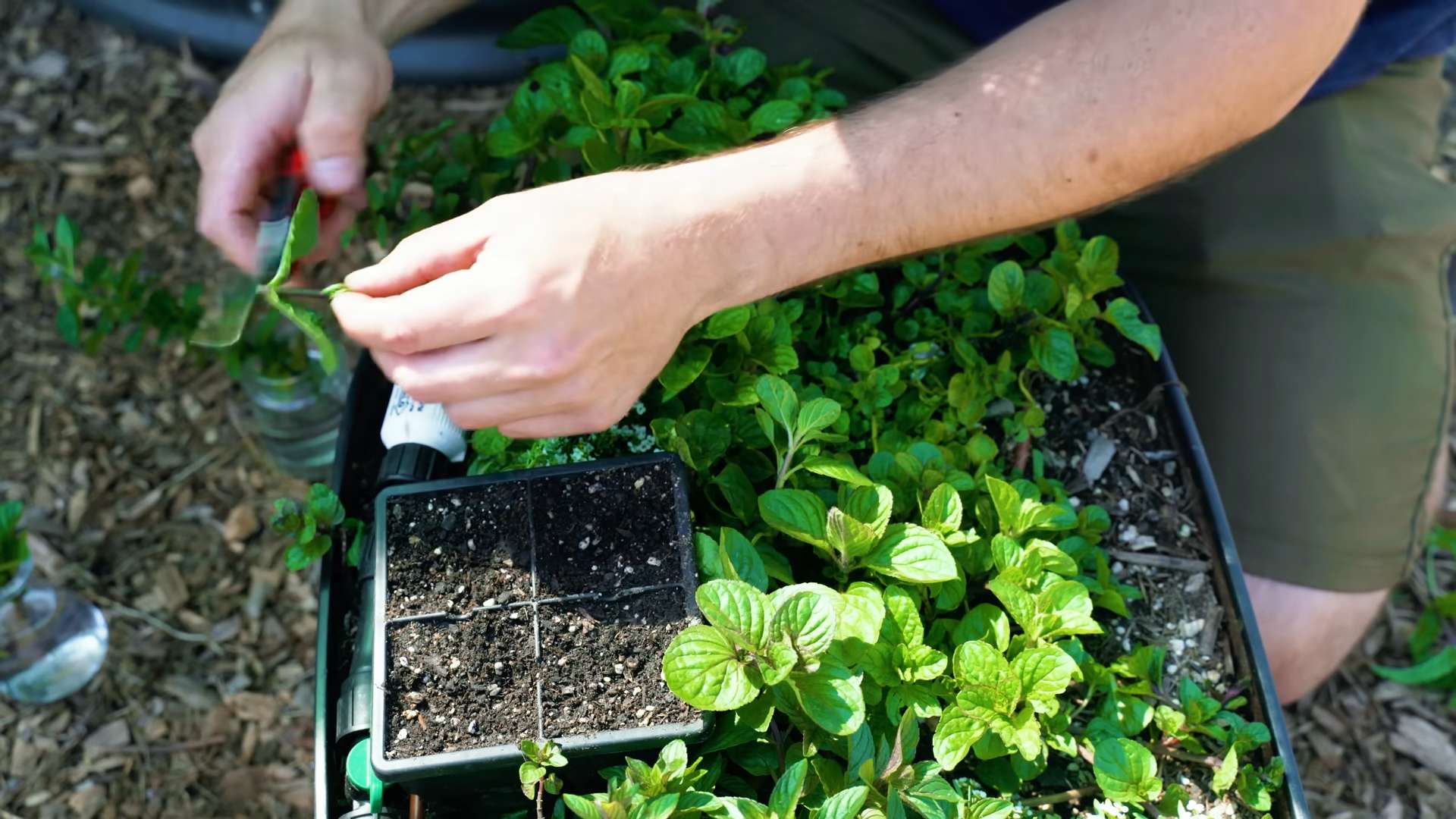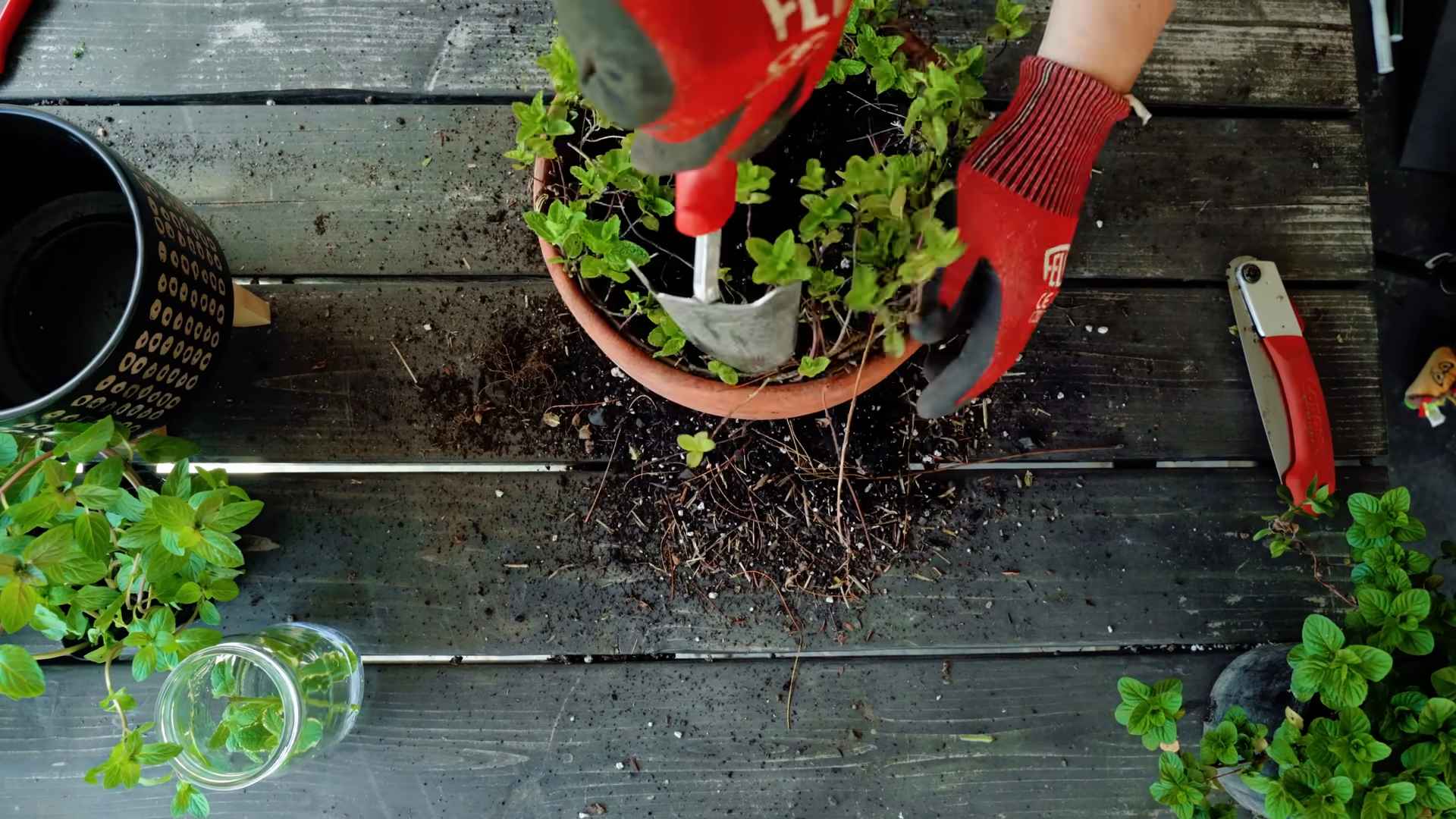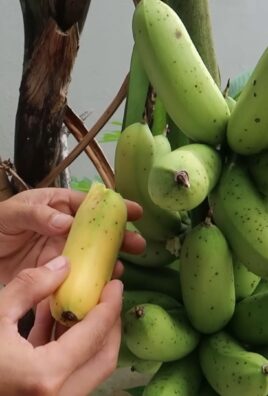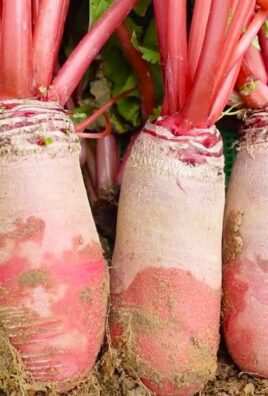Indoor Mint Growing: Unlock the secrets to a fragrant and thriving herb garden right inside your home! Have you ever dreamed of snipping fresh mint leaves for your morning tea or adding a vibrant touch to your favorite cocktails, all without stepping foot outside? Well, dream no more! This DIY guide is your passport to a world of aromatic bliss, where you’ll learn simple yet effective techniques to cultivate lush mint indoors, regardless of your gardening experience.
Mint, with its refreshing scent and versatile uses, has been cherished for centuries. From ancient medicinal practices to culinary delights, this herb boasts a rich history across cultures. But let’s face it, sometimes life gets in the way, and maintaining an outdoor garden can feel like a daunting task. That’s where the magic of indoor mint growing comes in!
I understand the frustration of buying wilted, overpriced mint from the grocery store when you could have a flourishing supply at your fingertips. This DIY guide will empower you to bypass those disappointments and enjoy the satisfaction of harvesting your own fresh mint whenever you desire. We’ll cover everything from choosing the right container and soil to providing optimal light and water, ensuring your indoor mint thrives and fills your home with its invigorating aroma. Get ready to embark on a rewarding journey of indoor gardening, one mint leaf at a time!

Growing Mint Indoors: A Beginner’s Guide to Fresh Flavor All Year Round
Hey there, fellow herb enthusiasts! Ever dreamt of having fresh, fragrant mint readily available, no matter the season? Well, you’re in the right place! I’m going to walk you through everything you need to know to successfully grow mint indoors. It’s easier than you think, and the reward of having your own homegrown mint for mojitos, teas, or culinary creations is totally worth it.
Choosing the Right Mint Variety
First things first, let’s talk about mint varieties. There’s a whole world beyond just “mint”! While spearmint and peppermint are the most common, you can also find chocolate mint, apple mint, orange mint, and even pineapple mint. Each has its own unique flavor profile, so experiment and find your favorites!
* Spearmint: Classic mint flavor, great for teas and sauces.
* Peppermint: Stronger, more intense flavor, perfect for candies and desserts.
* Chocolate Mint: A hint of chocolate aroma and flavor, delicious in desserts and drinks.
* Apple Mint: Milder, fruity flavor, good for salads and garnishes.
For indoor growing, I recommend starting with spearmint or peppermint, as they tend to be more resilient. Once you get the hang of it, you can branch out and try other varieties.
Essential Supplies You’ll Need
Before we dive into the growing process, let’s gather our supplies. Here’s what you’ll need:
* Mint Plant or Cuttings: You can either buy a small mint plant from a nursery or propagate your own from cuttings (more on that later!).
* Pot with Drainage Holes: Choose a pot that’s at least 6 inches in diameter to give your mint room to grow. Drainage is crucial to prevent root rot.
* Potting Mix: Use a well-draining potting mix specifically formulated for herbs or vegetables. Avoid using garden soil, as it can be too heavy and compact.
* Watering Can or Spray Bottle: For gentle watering.
* Grow Light (Optional but Recommended): Especially if you don’t have a sunny windowsill.
* Liquid Fertilizer: A balanced liquid fertilizer to feed your mint every few weeks.
* Scissors or Pruning Shears: For harvesting and pruning.
Propagating Mint from Cuttings (Optional)
If you already have a friend with a mint plant, or you see some healthy mint at the grocery store, you can easily propagate your own from cuttings. This is a fun and cost-effective way to expand your mint collection.
1. Select a Healthy Stem: Choose a stem that’s about 4-6 inches long and has several leaves.
2. Remove Lower Leaves: Gently remove the leaves from the bottom 2 inches of the stem. This is where the roots will grow.
3. Place in Water: Put the stem in a glass or jar filled with water, making sure the bottom nodes (where the leaves were removed) are submerged.
4. Wait for Roots: Place the jar in a bright, indirect light location. Change the water every few days. You should see roots starting to form within a week or two.
5. Plant in Potting Mix: Once the roots are about an inch long, you can plant the cutting in a pot filled with potting mix.
Planting Your Mint
Whether you’re starting with a store-bought plant or a cutting, the planting process is the same.
1. Prepare the Pot: Fill the pot with potting mix, leaving about an inch of space at the top.
2. Create a Hole: Dig a hole in the center of the potting mix that’s large enough to accommodate the root ball of your mint plant or the roots of your cutting.
3. Plant the Mint: Gently remove the mint plant from its original container (if applicable) and loosen the roots slightly. Place the plant or cutting in the hole and cover the roots with potting mix.
4. Water Thoroughly: Water the potting mix until it’s evenly moist.
Caring for Your Indoor Mint
Now comes the fun part: nurturing your mint and watching it thrive! Here’s what you need to know about providing the right environment and care.
Light
Mint loves light! Aim for at least 6-8 hours of sunlight per day. A south-facing windowsill is ideal. If you don’t have enough natural light, supplement with a grow light. I’ve found that LED grow lights work really well and don’t generate too much heat.
Watering
Keep the potting mix consistently moist, but not soggy. Water when the top inch of soil feels dry to the touch. Overwatering can lead to root rot, so be careful not to overdo it. I usually water my mint every 2-3 days, but this will vary depending on the temperature and humidity in your home.
Temperature
Mint prefers temperatures between 65°F and 75°F (18°C and 24°C). Avoid placing your mint near drafts or heat sources.
Humidity
Mint enjoys moderate humidity. If your home is particularly dry, you can increase the humidity around your mint by misting it with water regularly or placing a tray of water near the plant.
Fertilizing
Feed your mint with a balanced liquid fertilizer every 2-4 weeks during the growing season (spring and summer). Follow the instructions on the fertilizer label.
Pruning and Harvesting
Pruning is essential for keeping your mint plant healthy and productive. Regular pruning encourages bushier growth and prevents the plant from becoming leggy.
* Pinch Back the Tips: Pinch back the tips of the stems regularly to encourage branching.
* Harvest Frequently: Don’t be afraid to harvest your mint! The more you harvest, the more it will grow. Simply snip off stems as needed.
* Remove Flowers: Mint tends to flower, which can reduce leaf production. Remove any flowers that appear to encourage more leaf growth.
Dealing with Common Problems
Even with the best care, you might encounter a few problems along the way. Here are some common issues and how to address them:
* Pests: Aphids, spider mites, and whiteflies can sometimes infest mint plants. Inspect your plant regularly for signs of pests. If you find any, you can try washing them off with a strong stream of water or using an insecticidal soap.
* Root Rot: Root rot is caused by overwatering. If you suspect root rot, reduce watering and make sure your pot has good drainage. You may also need to repot the plant in fresh potting mix.
* Yellowing Leaves: Yellowing leaves can be a sign of overwatering, underwatering, or nutrient deficiency. Adjust your watering schedule and fertilize your plant if necessary.
* Leggy Growth: Leggy growth is caused by insufficient light. Move your plant to a brighter location or supplement with a grow light.
Enjoying Your Homegrown Mint
The best part of growing mint indoors is being able to enjoy the fresh flavor whenever you want! Here are just a few ways to use your homegrown mint:
* Teas: Add fresh mint leaves to hot or iced tea for a refreshing flavor.
* Mojitos: Muddle mint leaves with lime juice, sugar, and rum for a classic mojito.
* Salads: Add chopped mint leaves to salads for a burst of freshness.
* Sauces: Use mint in sauces for lamb, chicken, or fish.
* Desserts: Add mint to desserts like chocolate mousse, ice cream, or fruit salads.
* Garnish: Use mint sprigs as a garnish for cocktails, desserts, or savory dishes.
Overwintering Your Mint
Mint is a perennial plant, which means it can live for several years. However, it may go dormant during the winter months. To overwinter your mint indoors, reduce watering and fertilizing. Place the plant in a cool, bright location. You may notice that the plant stops growing or even loses some of its leaves. Don’t worry, this is normal. In the spring, resume your regular watering and fertilizing schedule, and your mint will start to grow again.
Troubleshooting: My Mint Isn’t Thriving!
Okay, so you’ve followed all the steps, but your mint still isn’t looking its best? Let’s troubleshoot!
* Not Enough Light: This is the most common culprit. Even if you think your windowsill is sunny, it might not be enough, especially in winter. Try moving your mint to a brighter spot or investing in a grow light.
* Overwatering: Soggy soil is a mint killer. Make sure your pot has drainage holes and let the top inch of soil dry out before watering again.
* Underwatering: On the flip side, letting your mint dry out completely will also cause problems. Check the soil moisture regularly and water when needed

Conclusion
So, there you have it! Mastering the art of indoor mint growing is not only achievable but also incredibly rewarding. We’ve walked you through the essential steps, from selecting the right variety and providing optimal lighting to ensuring proper watering and pest control. But why is this DIY trick a must-try? Because fresh mint, readily available at your fingertips, elevates your culinary creations, brightens your beverages, and adds a touch of aromatic bliss to your home.
Imagine stepping into your kitchen and snipping a few sprigs of vibrant mint to garnish your morning smoothie, infuse your afternoon tea, or add a burst of freshness to your evening salad. No more last-minute trips to the grocery store or settling for wilted, lackluster herbs. With your own indoor mint garden, you’ll always have a supply of fragrant, flavorful mint at your disposal.
But the benefits extend beyond convenience and culinary enhancement. Nurturing a plant, watching it grow, and harvesting its bounty is a deeply satisfying experience. It connects you to nature, even within the confines of your home, and provides a sense of accomplishment. Plus, the invigorating scent of mint can uplift your mood and create a more inviting atmosphere.
Now, let’s talk about variations. While we’ve focused on the basics, there’s plenty of room for experimentation. Try growing different varieties of mint, such as peppermint, spearmint, chocolate mint, or even apple mint. Each variety offers a unique flavor profile and aroma, allowing you to customize your indoor garden to your personal preferences.
You can also explore different growing methods. While we’ve emphasized using pots and soil, you could also try hydroponics or aquaponics for a more advanced and sustainable approach. These methods involve growing plants without soil, using nutrient-rich water solutions.
Another fun variation is to create a miniature herb garden, combining mint with other complementary herbs like basil, parsley, and chives. This allows you to have a diverse selection of fresh herbs readily available for your culinary adventures.
Don’t be afraid to experiment with different lighting conditions. While mint thrives in bright, indirect light, you can also supplement with grow lights if you don’t have access to a sunny windowsill. This is especially helpful during the winter months when natural light is scarce.
Remember to prune your mint regularly to encourage bushier growth and prevent it from becoming leggy. Pinch off the top leaves and stems to promote side shoots and maintain a compact shape.
We wholeheartedly encourage you to embark on this indoor mint growing journey. It’s a simple, affordable, and incredibly rewarding project that will transform your kitchen and elevate your culinary experiences.
So, grab a pot, some soil, and a mint seedling or cuttings, and get started today! We’re confident that you’ll be amazed by the results.
And most importantly, we want to hear about your experience! Share your tips, tricks, and successes with us in the comments below. Let’s create a community of indoor mint growers and learn from each other. What varieties are you growing? What challenges have you faced? What are your favorite ways to use your fresh mint? We can’t wait to hear your stories!
Frequently Asked Questions (FAQ)
What is the best type of mint to grow indoors?
The best type of mint to grow indoors depends on your personal preferences and intended use. Spearmint and peppermint are two of the most popular and readily available varieties. Spearmint has a milder, sweeter flavor that’s perfect for teas, cocktails, and salads. Peppermint has a stronger, more intense flavor that’s ideal for desserts, candies, and medicinal purposes. Other varieties to consider include chocolate mint (which has a hint of chocolate flavor), apple mint (which has a fruity aroma), and orange mint (which has a citrusy scent). Experiment with different varieties to find your favorites!
How much light does indoor mint need?
Mint thrives in bright, indirect light. Ideally, it should receive at least 4-6 hours of sunlight per day. A south-facing or east-facing window is usually a good choice. If you don’t have access to a sunny windowsill, you can supplement with grow lights. Place the grow lights about 6-12 inches above the plant and keep them on for 12-16 hours per day. Insufficient light can cause the mint to become leggy and produce fewer leaves.
How often should I water my indoor mint?
Water your indoor mint regularly, keeping the soil consistently moist but not waterlogged. Check the soil moisture by sticking your finger about an inch into the soil. If it feels dry, it’s time to water. Water thoroughly until excess water drains out of the bottom of the pot. Avoid letting the pot sit in standing water, as this can lead to root rot. The frequency of watering will depend on factors such as the size of the pot, the type of soil, and the temperature and humidity of your home.
How do I prevent pests from attacking my indoor mint?
Pests can be a problem for indoor mint, but there are several things you can do to prevent them. Regularly inspect your plants for signs of pests, such as aphids, spider mites, or whiteflies. If you spot any pests, you can try washing them off with a strong stream of water or using insecticidal soap. Avoid using harsh chemicals, as these can damage the plant and contaminate the leaves. You can also try introducing beneficial insects, such as ladybugs or lacewings, to control pests naturally.
How do I harvest my indoor mint?
Harvest your indoor mint regularly to encourage bushier growth and prevent it from becoming leggy. Simply pinch off the top leaves and stems, leaving at least a few leaves on each stem. You can harvest up to one-third of the plant at a time. The best time to harvest mint is in the morning, after the dew has dried but before the sun gets too hot. This is when the leaves are at their most flavorful.
Can I grow mint from cuttings?
Yes, growing mint from cuttings is a very easy and effective way to propagate new plants. Take a cutting that is about 4-6 inches long, removing the leaves from the bottom 2 inches of the stem. Place the cutting in a glass of water, making sure that the bottom nodes are submerged. Change the water every few days. After a few weeks, roots will begin to form. Once the roots are about an inch long, you can transplant the cutting into a pot of soil.
Why is my indoor mint turning yellow?
Yellowing leaves on indoor mint can be caused by several factors, including overwatering, underwatering, nutrient deficiencies, or pest infestations. Check the soil moisture to make sure you’re not overwatering or underwatering. If the soil is consistently wet, allow it to dry out slightly before watering again. If the soil is dry, water thoroughly. You can also try fertilizing your mint with a balanced liquid fertilizer to address any nutrient deficiencies. Inspect the plant for pests and treat accordingly.
How do I make my indoor mint bushier?
To make your indoor mint bushier, prune it regularly by pinching off the top leaves and stems. This encourages the plant to produce side shoots, resulting in a fuller, more compact shape. You can also fertilize your mint with a balanced liquid fertilizer to promote healthy growth. Make sure the plant is receiving adequate light, as insufficient light can cause it to become leggy.
Can I grow mint in water only?
Yes, you can grow mint in water only, using a method called hydroponics. Simply place a mint cutting in a glass of water, making sure that the bottom nodes are submerged. Change the water every few days and add a few drops of liquid fertilizer to provide nutrients. The mint will grow roots and continue to produce leaves in the water. However, mint grown in water may not be as flavorful as mint grown in soil.
Is indoor mint growing worth the effort?
Absolutely! The effort required for indoor mint growing is minimal compared to the rewards. Having fresh mint readily available for culinary uses, beverages, and aromatherapy is a delightful convenience. Plus, the process of nurturing a plant and watching it thrive is incredibly satisfying. Give it a try, and you’ll likely find that indoor mint growing is a worthwhile and enjoyable hobby.




Leave a Comment